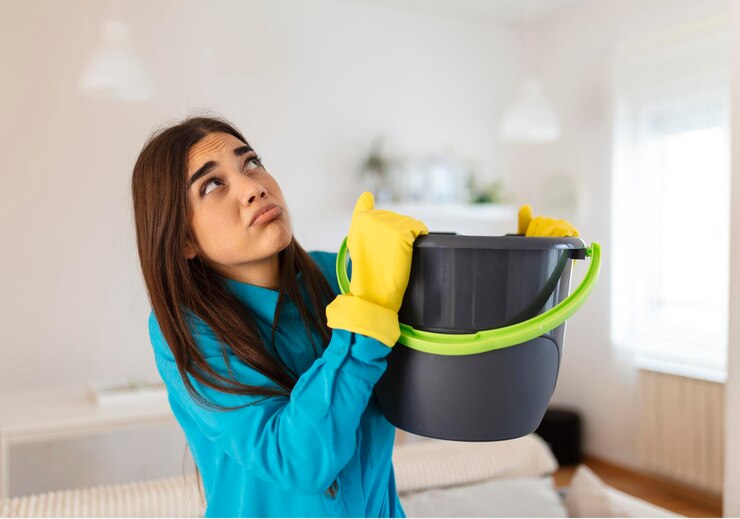 5 Dec 2024
5 Dec 2024
Water leaking from the ceiling can be a serious issue, causing damage to your home and belongings if not addressed quickly. Acting promptly is key to minimizing damage and repair costs. With a clear action plan, you can effectively manage the situation and prevent future leaks.
This guide outlines essential steps for identifying the leak’s source, protecting your belongings, containing the water, drying the area, and determining when to call a professional.
Step 1: Identify the Source of the Leak
The first step is to determine where the water is coming from. Common sources include plumbing pipes, roofs, or appliances. Here’s how to identify the source:
- Plumbing Issues: Inspect bathroom fixtures, kitchen sinks, or pipes for leaks. Look for wet spots, mould, or dripping water on walls and ceilings.
- Roof Damage: Check your attic and roof for missing shingles, cracks, or holes. Rainwater may seep through these openings and cause leaks.
- Appliances: Faulty appliances like water heaters, washing machines, or air conditioners can lead to leaks. Check for water pooling around these devices.
Understanding the source will help you assess the severity and choose the right course of action.
Step 2: Turn Off the Water Supply
If a plumbing issue is suspected, shut off the water supply immediately to limit further damage. Locate your home’s main water shutoff valve and turn it off. For leaking appliances, turn off both the appliance and its water supply.
Step 3: Contain the Leak
Once the water is stopped, contain the leak to protect your home and belongings:
- Use buckets, towels, or absorbent materials to collect dripping water.
- Move furniture and valuables away from the affected area.
- Cover larger items with plastic sheets or tarps to shield them from water damage.
Step 4: Contact a Professional
Engage a professional to address the root cause of the leak. Depending on the issue, you may need:
- Plumbers: For leaks originating from pipes or plumbing systems.
- Roofing Contractors: For roof-related issues like missing shingles or structural damage.
- Appliance Technicians: For repairs to water heaters or other leaking appliances.
Experienced professionals ensure repairs are thorough and prevent recurring issues.
Step 5: Dry the Affected Area
Thoroughly drying the area is critical to preventing mould and further damage. Use fans, dehumidifiers, and open windows to improve air circulation. Ensure carpets, drywall, and insulation are completely dry before proceeding with repairs. Remove and replace any materials that remain damp.
Step 6: Assess the Damage
Evaluate the extent of water damage after drying the area. Look for:
- Stains or Discoloration: Visible on walls, ceilings, or floors, indicating the leak’s impact.
- Mold or Mildew: A serious health hazard that requires immediate attention.
- Structural Damage: Weakness in wood, drywall, or other materials compromising your home’s integrity.
Document damage with photos and notes for insurance claims or contractor discussions.
Step 7: Make Necessary Repairs
Repair all damaged areas and ensure the source of the leak is completely fixed. Typical repairs include:
- Drywall: Replace water-damaged sections, ensuring the area is dry before installation.
- Insulation: Replace wet insulation to maintain energy efficiency and prevent mould.
- Flooring: Depending on the material and extent of the damage, replace affected flooring.
Hiring professionals for complex repairs ensures quality and safety.
Step 8: Prevent Future Leaks
Preventive maintenance reduces the risk of future leaks:
- Roof Inspections: Regularly check for missing shingles, cracks, or other vulnerabilities.
- Plumbing Maintenance: Inspect pipes for leaks or corrosion and address minor issues before they escalate.
- Appliance Servicing: Schedule routine maintenance for water heaters, washing machines, and air conditioners. Replace worn parts as needed.
Conclusion
When water leaks from your ceiling, prompt action is essential. Start by identifying the source, shutting off the water supply, and containing the leak. Engage a professional to handle repairs, thoroughly dry the area, and assess the damage. Once the repairs are complete, implement preventive measures to safeguard your home against future leaks.
For reliable assistance, consider Heng Plumbing. Our expertise ensures swift and professional handling of plumbing issues, helping you maintain a safe, leak-free home.
